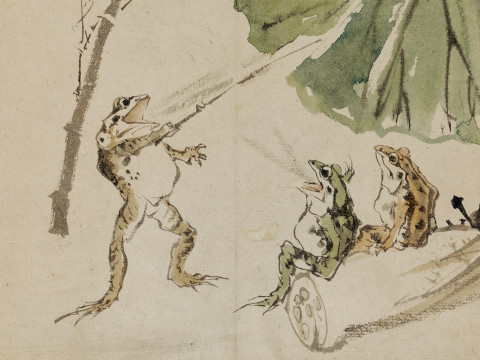
How to read it: Constable's Flatford Mill study
By RA Collections team
Published on 5 January 2017
Painted quickly to develop ideas before the final work, this is one of 16 oil sketches by John Constable RA in our collection. Here's an introduction to Flatford Mill from a Lock on the Stour.
What is it?
Throughout his career, Constable made oil sketches of this 17th-century corn mill, owned by his father, Golding Constable, a corn merchant in the Suffolk village of East Bergholt. Flatford Mill from a lock on the Stour, one of John Constable's earlier works, demonstrates his connection with his childhood home; he said he associated the river Stour with his "careless boyhood." In this composition the river, trees and sky dominate the view, but he provides details of our interaction with nature – via agriculture and industry – through the inclusion of reapers in the field beyond the trees.
What is this a study for?
It's thought that Constable painted this sketch to explore ideas for a painting with the same composition and name, Flatford Mill from the Lock, which he exhibited at the Royal Academy in 1812. Constable is known for his impasto technique, which uses thickly loaded brushes or palette knives. In this sketch, which he worked on in the open air, he captures the light and a sense of movement in the trees and water with loose brushstrokes.

When was it made?
There has been much debate surrounding the date of this painting due to Constable's inscription on the back, which may read 1810 or 1811. We know that Constable was painting in Flatford in these years due to his mother's letters. In one, dated 26th October 1811, she wrote "Your Father…rode down to Flatford. Your pretty view from there is so forward… and I am certain it will gain an applause, for everyone approves it". Little did she know we would be celebrating it over 200 years later.
Painting is another word for feeling. I associate my “careless boyhood” to all that lies on the banks of the Stour. They made me a painter (& I am grateful) that is I had often thought of pictures of them before I had even touched a pencil.
John Constable RA
More about Constable
Constable was the second son in his family – but was given responsibility for taking over his father's business. In 1799 he persuaded his father to let him pursue art and entered the Royal Academy Schools. By 1802 he was offered the position of drawing master at Great Marlow Military College but turned it down to pursue his dream of becoming a professional landscape painter. 1817 marked a significant change in his career when he decided to create six-foot paintings, such as The Leaping Horse, continuing the theme of his father's corn mill and the Stour. In a letter in 1821 to his closest friend, John Fisher, he wrote "I should paint my own places best." Constable credited these places, and his childhood countryside sketches, with his success: they "made me a painter, and I am grateful."

Related articles

The meteoric rise of Angelica Kauffman RA
2 January 2024

Untold Stories
26 October 2023



